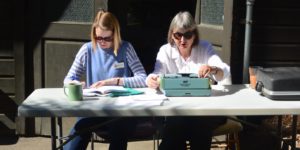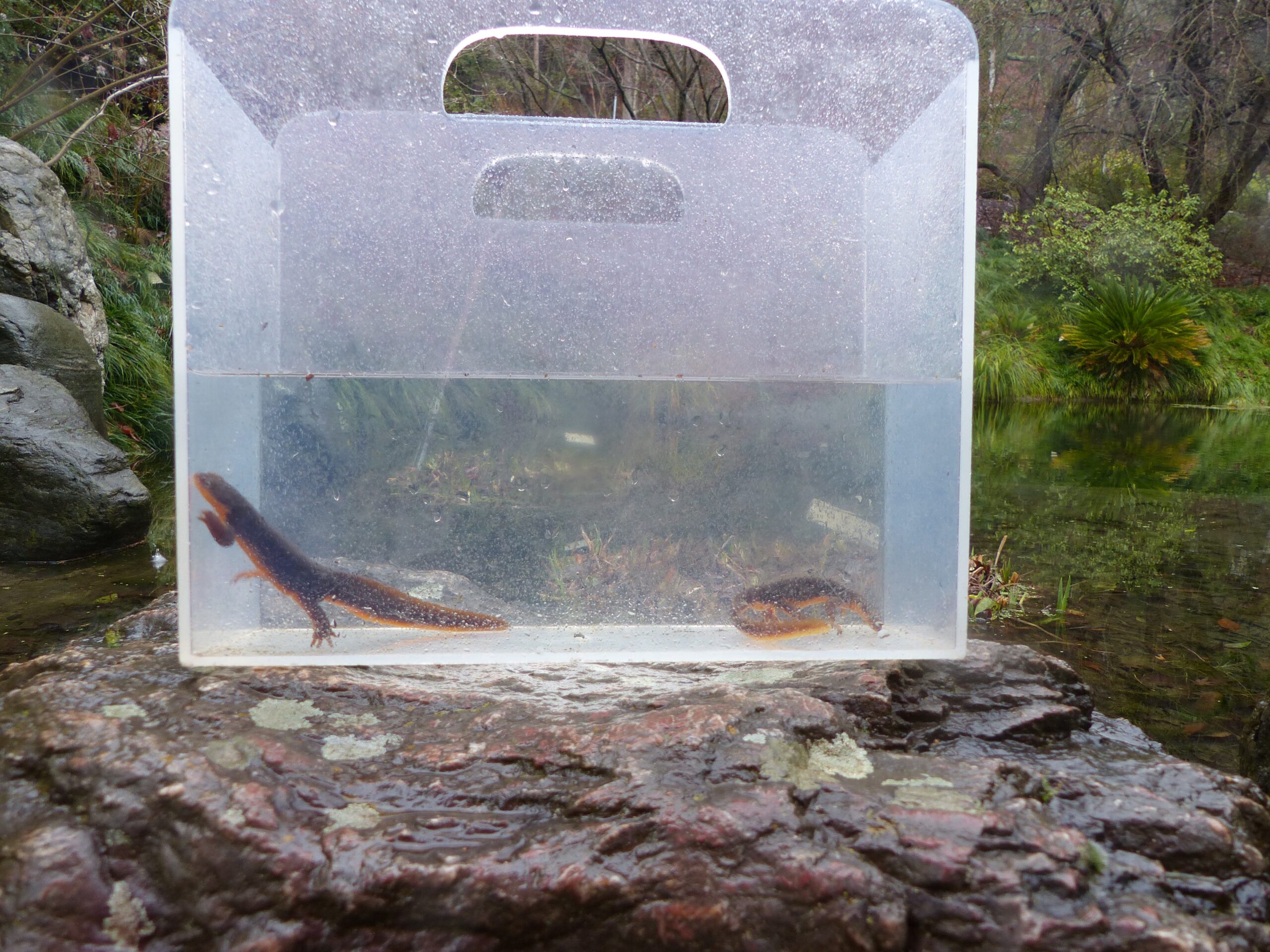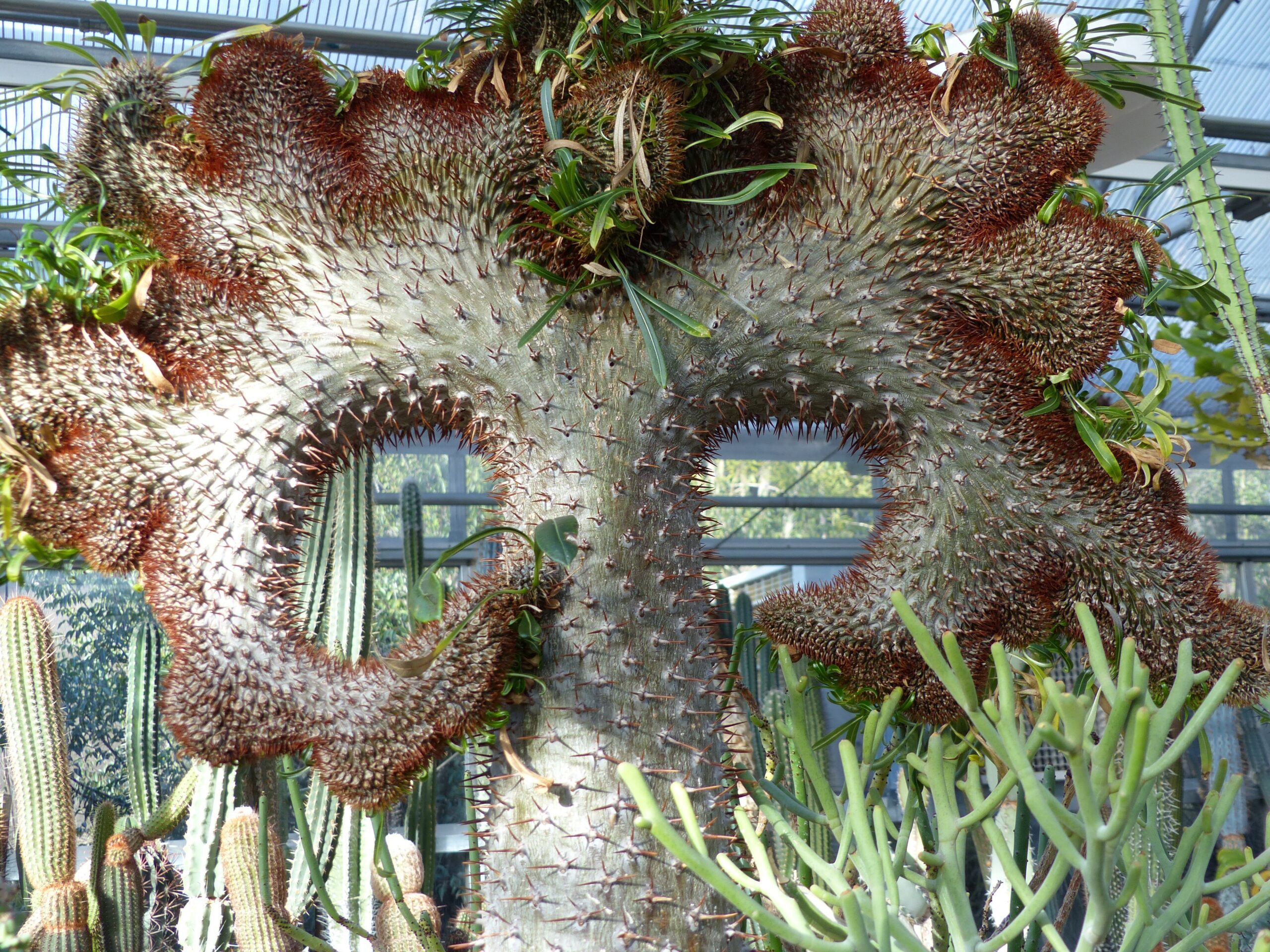
A garden is where plants and people collide. And sometimes, you look down and find words in the garden, too: those little silver placards carrying botanical names, or an instructional voice in your head—an authority’s idea about what should be grown and how. If you’re lucky, the language in the garden might have been encouraged to grow by the poets Hazel White and Denise Newman, two San Francisco-based collaborators who sowed experimental seeds at the UC Botanical Garden in Berkeley for about a year and a half, ending in 2016.
Their Biotic Portal project is delightfully multifaceted, with Facebook posts and videos and essays, and a multimedia index that mimics the garden’s horticultural records. It shelters such tasty bits of language (“pretend your body is a tentacle”) and is fascinating in that most of those bits were not written by White and Newman, but recorded during their interactions with hundreds of visitors and staff at the garden.
And why not? Poetry is often so nearly silent, floating on the page, unseen and unheard by the vast majority of people, even those who read. I sense in Newman and White the desire to break down the barriers between poetry and the world, to get out there and chat, even as they undertook brainy inquiries about the nature of beauty and how a seemingly innocent activity, like collecting plants, can conceal human power dynamics.
Both women have had careers outside the standard borders of poetryland. White has written a number of instructional gardening books, and Newman has supplied opera libretti and made videos of snails. “We advanced by instinct and play,” White told me during our interview, and Biotic Portal—both during its real-time incarnation in California, and at its more permanent home online—issues a serious invitation to the audience to enter the garden and play along with the poets.
***
The Rumpus: Can you describe how this project got started?
Hazel White: After we got the grant from the Creative Work Fund in 2015 to collaborate with the UC Botanical Garden at Berkeley, we spent a few months visiting the garden and weighing up our grant proposal, which was to place text on-site. During that time, we wrote an article for World Literature Today on the use of text in landscape projects by writers and artists. We then looked at all the fixed, static language in the garden, and decided there was already too much language there.
Rumpus: I’m intrigued by that phrase, “too much language”—it’s always fascinating to notice and ponder the ways that language in a public/educational space can become authoritative and maybe even oppressive, directing and containing a person’s experience there. Was that your concern—an overly mediated environment, and a longing for the things themselves? Or was it something more practical, like not wanting to require people to spend too much time reading text, thus having less time for plants?
Denise Newman: All of that. We noticed the scientific signage had considerable authority. The eye would go right to the sign, then over to the plant, and back again. The information (genus and species—in Latin, and often of colonial origin—common name, acquisition date, etc.) often created distance rather than connecting people to the plant or the beautiful canyon in which the garden lies. The large interpretive signs were usually completely overlooked. The passive authority of this “living museum of plants” was our main challenge. We were seeking liveliness. We were particularly excited by a piece of skywriting we wrote about, “Don’t Panic,” by Ruth Sacks. The other projects we wrote about also put language in just as much flux as its surroundings.
Rumpus: It seems you found plenty of liveliness within the plants themselves. But also, I sense you do believe in the enriching mission of the garden for the public. One of the project essays ends, “Please return to the garden again and again. Nothing would make the gardeners and staff happier.” Is the botanical garden good for people?
White: Yes, the garden is very good for people! The text you mention is from the site essay on beauty, where I investigated how beauty affects felt experience. I mentioned Simone Weil’s idea that it distributes our attention outside of ourselves, requires us “to give up our imaginary position as the center.” That’s exactly the radical change we need today, we kept thinking.
Elaine Scarry, in her book On Beauty and Being Just, proposes that beauty can lead to a greater alertness of and desire for fairness. It “seems to incite, even to require, the act of replication,” she writes, so opening oneself to incidences of beauty initiates more acts of beauty, which cause new chains of replication. It was in thinking about that that I encouraged people to return again and again, to make beauty and change a practice, really, to enliven social space with its benefits—chiefly, empathy and generosity.
What does this have to do with poetry? There is another quote in that essay from poet Andrew Joron about the “poetic-revolutionary nature of reality,” whereby complex systems “comprised of a large number of elements far from equilibrium are prone to beautiful convulsions … [and then] an unexpected, unprecedented superaddition to reality … emerges.” We think poetry, like the garden, is a model of this “overflowing of reality,” and perhaps that’s what made it so easy for the gardeners and our collaborators to connect with our project.
Rumpus: How did the gardeners and the public become part of the project?
Newman/White: We took over a large closet between the women’s and men’s bathrooms and held open studios every Friday from October 2015 until September 2016. We had props in the form of a question or an object to draw visitors into speaking about things like shelter and desire. We collected their language, as well as our own thoughts and research provoked by these meetings. The garden staff became valuable collaborators, bringing us animated words like “autumnal recrudescence,” pointing out nests and rat damage and slime molds, describing deer kills and failures.
Every Friday a sign was put out at the entrance kiosk: “Poets in the Garden.” People expected us to be writing poems. Some, including the garden director, had a hard time understanding how our project had anything to do with poetry. But they said startlingly lively things, bits of poetry floating in the air, which we couldn’t help collecting.
Rumpus: Was there a moment or an exchange that seemed emblematic of how the public reacted to your presence? Did you get better at explaining the project as it went on?
Newman: Once we settled on the form of the index, we were able to explain to people how we were going to use their words. We called it a public poem, or a poetic reordering of the collection. We had to keep changing our methods of engaging others because we needed to risk something ourselves if we were going to ask people to step into uncertainty. There was an exciting moment during one of our public walks that seems emblematic: Hazel described to the group a deer kill by a mountain lion on the other side of the boundary fence. She had us think about our love of shelter and security and the traditional idea of the garden as a paradise separate from the world, behind walls. I asked everyone to write down what the boundary fence fails to keep out, and then, as a chorus, we all shouted out our lists: Pollution, noise, crime, birds, clouds, pests, good climbers, wanderers, doubt, smells, drones, bugs, poverty, sounds, imagination, etc. All this appears in the index under the heading “Fence around the garden” and is cross-listed with Grizzlies, Boundary fences, Paradise, and Shelter.
Rumpus: You have both published work in conventional forms (i.e., books of poetry), but you have both also found ways to put experimental language into other kinds of spaces and planes, like music and social media. Why is that important to you? Is there a gesture toward mindfulness here, in the sense that both nature and language may reward attention anywhere they exist, not only in their respective “gardens”?
White: Yes, I like that idea of nature and language rewarding attention anywhere they exist. It reminds me of Myung Mi Kim on radicalizing poetry: “to work out as many different models of where poetry can exist, where poetry can be inserted.” She insists that radicalization begins with a rupture, and working with the public, off the traditional page, feels like that.
While I was at Headlands Center for the Arts, I went twice a week to Battery 129, an old military site, with three tunnels and a gun pit, overlooking San Francisco and the Pacific Ocean. I met tourists, National Park Service employees, and military veterans there. The place is stunning, a complex of shelter and exposure, beauty and war, play and discomfort, and what came out of our mouths surprised us. Buffeted by the wind, affected by the war equipment, in awe of the view, perhaps we were uttering a very somatic/phenotypic language. Something similar happened at the botanic garden. Public work can feel very rich.
Newman: For me, collaboration and working off the page have been ways to destabilize the process and engage more directly with others and the environment. I started collaborating with composers almost two decades ago, providing text for choral works. For my last project with composer Mark Winges, Pandora’s Gift, I held poetry workshops with the children singers and worked their language into the middle section when Pandora opens the box. The more people involved, the greater the unpredictability, and pressure that it could all fall apart at any moment. Making videos is similar. I’ve filmed insects and other elements moving language around, like this early video of snails, and learned to be patient and ready, setting up the conditions and waiting for something surprising to happen. All of this work prepared me for the poetry collaboration.
Rumpus: The Cagean imperative is to accept whatever comes into the space you have created through, as you say, Denise, “setting up the conditions.” It’s the idea that anything that enters your designated form is valid, and the possibility of allowing or even loving anything. When I bring this back around to the garden setting, it raises a lot of entrenched binaries to which you’ve alluded, like natural vs. unnatural, invasive vs. native, weeds vs. cultivated species. Is there something to be gained by relaxing our ideas about what should and shouldn’t be in the garden?
White: The botanic garden is a curated collection, and nothing is allowed to grow there from seed, because its genetic heritage must be traceable or the authority of the collection is compromised. This strict set of curatorial conditions gave us the chance to be Cagean monitors, playing with everything that refused the form. We loved the outlaw intrusions of blackberries, the thefts, the stories of disaster, the “dead file” of plant failures, which are far more numerous than the living. And we loved the animals in the garden, and so did the visitors. Perhaps we delighted in their overturning the set conditions.
The biggest question there each spring has nothing to do with the survival of anything in the collection but rather how many local newts will make it across the road, through the garden fence to mate in the “Asia” pond. One of the last things we did in the garden was make a night video. We wore uniforms and furtively went around putting black cloths over signs and opening doors, returning the garden to the wildlife. What should and shouldn’t be in the garden—it brings up who’s in charge, what relationship do we want to our habitat.
Rumpus: It’s so much fun to think of being an outlaw in the garden, and reminds me of evolution—that the dead, or the extinct, are “far more numerous than the living.” Nature, too, might be a trickster, continually disrupting stasis. What was the weirdest biological or ecological phenomenon you witnessed at the botanic garden? The most hopeful human phenomenon?
Newman: Yes, the outlaws poke holes in the fantasy of a garden as paradise; they keep it real, whereas the anomalies are the darlings of the collection. Weird phenomena of all kinds were a major theme for us; our first entry in the index is “Aberration,” (“only valued when it’s not our own species, See also Affection”) with the photo of a one-of-kind Pachypodium lamerei. If you then go to the entry “Affection,” you’ll find the botanical term “monstrose,” which is what happened to this cactus, it had a growth mutation caused by an injury or disease. What’s so unusual about this plant is how symmetrical its bifurcated mutation is, like a pair of fantastic spectacles.
This plant might serve as an emblem for the giddy, hopeful atmosphere at the garden. Perhaps the wild abundance and diversity of plant life intoxicated people, enabled them to let down their guards and enter into open-field conversations with us. They said amazing, curious things, and it often seemed like they were saying them out loud for the first time. It made us wonder what it might mean in the larger world. In the right setting, could little awakenings into collaborative participation create a wave that tips toward change, to a greater sense of connectedness?
Rumpus: At one point in the piece, you mention place being “finally, sturdily, grounded on multiplicities of human relation.” Speaking of human relation, did politics or social issues per se enter this project, given the interest you described above in empathy and de-centering one’s own point of view?
White: “Pincushion of a million stories,” is how geographer Doreen Massey spoke of place. Our project strikes us now as partly a poetic anthology of place in that sense. People were talking about Hillary vs. Bernie, disability access, global warming, money, the high cost of living in the Bay Area, land sovereignty, religion (lots on religion, actually, which led us to Bruno Latour’s “Will Non-Humans Be Saved? An Argument in Ecotheology”). We often brought up the colonial origin of plant collections, the colonial naming and Linnaean categorization of plants, and also of humans by race.
On one of our public walks, this one in collaboration with the Architecture of Life exhibit at the Berkeley Art Museum, a professor questioned the garden’s presentation of American Indian “artifacts” and we turned over our audience to listen to him. We had a stirring discussion about race with the garden administration. It was the time of the Clinton-Trump campaigns and continuing police violence against the black community, and the time of Denise’s mother being diagnosed with cancer, and my son, who’s black, facing police guns. The garden is a living scaffold of survival, our project a witness of its survival and people’s survival stories. I think Tacita Dean is probably right. “Place,” she said, “I realized it can only ever be personal.”
Rumpus: How did you first come together as collaborators? What did you learn about collaboration from this project?
Newman: We met at California College of the Arts. We were both interested in expanding the scope of poetry, and when the opportunity arose in 2012 to do a site-specific project together, we leaped at the chance. Our first piece was a poetry installation, part of an interdisciplinary group show called Natural Discourse. We discovered that working together we could enter terrain and produce work that would not be possible on our own.
We find that listening and contributing ideas are not separate activities. The one talking needs the other to listen for the gold flecks in the stream—What did you just say? Say that again! We also find that the decentered process makes us more daring. It’s always about the work, not the creator, but being two somehow reinforces this, the way you might speak up on someone else’s behalf more easily than on your own. The Creative Work Fund grant required that we work collaboratively with our partner organization, the botanic garden. Our well-established collaborative framework expanded easily to include the gardeners, staff, and visitors.
Rumpus: How did the project wrap up?
White: In September 2016, we presented the work at a grand closing dinner party at the garden. Attendees drank botanic cocktails and completed our final exercise, a pseudo-scientific “gumball” questionnaire to affirm their affiliations with nature—primordialist or activist or naturalist, etc. Poets Mg Roberts and Sarah Rosenthal presented responses to the project; Anthony Garza, supervisor of horticulture and grounds, wrote us a poem.
Rumpus: What do plants and people have in common?
Newman: The meaning of life for both is to grow.
White: Cells, feet, accidents, tropisms, nights, names, death.
***
Featured photograph of Denise Newman and Hazel White © Alex Nichols. All other photographs © Biotic Portal.







